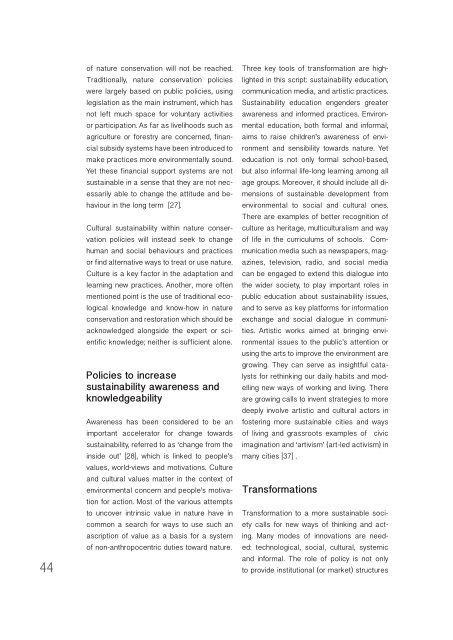Culture in for and as Sustainable Development
YIGflg
YIGflg
Create successful ePaper yourself
Turn your PDF publications into a flip-book with our unique Google optimized e-Paper software.
44<br />
of nature conservation will not be reached.<br />
Traditionally, nature conservation policies<br />
were largely b<strong>as</strong>ed on public policies, us<strong>in</strong>g<br />
legislation <strong>as</strong> the ma<strong>in</strong> <strong>in</strong>strument, which h<strong>as</strong><br />
not left much space <strong>for</strong> voluntary activities<br />
or participation. As far <strong>as</strong> livelihoods such <strong>as</strong><br />
agriculture or <strong>for</strong>estry are concerned, f<strong>in</strong>ancial<br />
subsidy systems have been <strong>in</strong>troduced to<br />
make practices more environmentally sound.<br />
Yet these f<strong>in</strong>ancial support systems are not<br />
susta<strong>in</strong>able <strong>in</strong> a sense that they are not necessarily<br />
able to change the attitude <strong>and</strong> behaviour<br />
<strong>in</strong> the long term [27].<br />
Cultural susta<strong>in</strong>ability with<strong>in</strong> nature conservation<br />
policies will <strong>in</strong>stead seek to change<br />
human <strong>and</strong> social behaviours <strong>and</strong> practices<br />
or f<strong>in</strong>d alternative ways to treat or use nature.<br />
<strong>Culture</strong> is a key factor <strong>in</strong> the adaptation <strong>and</strong><br />
learn<strong>in</strong>g new practices. Another, more often<br />
mentioned po<strong>in</strong>t is the use of traditional ecological<br />
knowledge <strong>and</strong> know-how <strong>in</strong> nature<br />
conservation <strong>and</strong> restoration which should be<br />
acknowledged alongside the expert or scientific<br />
knowledge; neither is sufficient alone.<br />
Policies to <strong>in</strong>cre<strong>as</strong>e<br />
susta<strong>in</strong>ability awareness <strong>and</strong><br />
knowledgeability<br />
Awareness h<strong>as</strong> been considered to be an<br />
important accelerator <strong>for</strong> change towards<br />
susta<strong>in</strong>ability, referred to <strong>as</strong> ‘change from the<br />
<strong>in</strong>side out’ [28], which is l<strong>in</strong>ked to people’s<br />
values, world-views <strong>and</strong> motivations. <strong>Culture</strong><br />
<strong>and</strong> cultural values matter <strong>in</strong> the context of<br />
environmental concern <strong>and</strong> people’s motivation<br />
<strong>for</strong> action. Most of the various attempts<br />
to uncover <strong>in</strong>tr<strong>in</strong>sic value <strong>in</strong> nature have <strong>in</strong><br />
common a search <strong>for</strong> ways to use such an<br />
<strong>as</strong>cription of value <strong>as</strong> a b<strong>as</strong>is <strong>for</strong> a system<br />
of non-anthropocentric duties toward nature.<br />
Three key tools of trans<strong>for</strong>mation are highlighted<br />
<strong>in</strong> this script: susta<strong>in</strong>ability education,<br />
communication media, <strong>and</strong> artistic practices.<br />
Susta<strong>in</strong>ability education engenders greater<br />
awareness <strong>and</strong> <strong>in</strong><strong>for</strong>med practices. Environmental<br />
education, both <strong>for</strong>mal <strong>and</strong> <strong>in</strong><strong>for</strong>mal,<br />
aims to raise children’s awareness of environment<br />
<strong>and</strong> sensibility towards nature. Yet<br />
education is not only <strong>for</strong>mal school-b<strong>as</strong>ed,<br />
but also <strong>in</strong><strong>for</strong>mal life-long learn<strong>in</strong>g among all<br />
age groups. Moreover, it should <strong>in</strong>clude all dimensions<br />
of susta<strong>in</strong>able development from<br />
environmental to social <strong>and</strong> cultural ones.<br />
There are examples of better recognition of<br />
culture <strong>as</strong> heritage, multiculturalism <strong>and</strong> way<br />
of life <strong>in</strong> the curriculums of schools. Communication<br />
media such <strong>as</strong> newspapers, magaz<strong>in</strong>es,<br />
television, radio, <strong>and</strong> social media<br />
can be engaged to extend this dialogue <strong>in</strong>to<br />
the wider society, to play important roles <strong>in</strong><br />
public education about susta<strong>in</strong>ability issues,<br />
<strong>and</strong> to serve <strong>as</strong> key plat<strong>for</strong>ms <strong>for</strong> <strong>in</strong><strong>for</strong>mation<br />
exchange <strong>and</strong> social dialogue <strong>in</strong> communities.<br />
Artistic works aimed at br<strong>in</strong>g<strong>in</strong>g environmental<br />
issues to the public’s attention or<br />
us<strong>in</strong>g the arts to improve the environment are<br />
grow<strong>in</strong>g. They can serve <strong>as</strong> <strong>in</strong>sightful catalysts<br />
<strong>for</strong> reth<strong>in</strong>k<strong>in</strong>g our daily habits <strong>and</strong> modell<strong>in</strong>g<br />
new ways of work<strong>in</strong>g <strong>and</strong> liv<strong>in</strong>g. There<br />
are grow<strong>in</strong>g calls to <strong>in</strong>vent strategies to more<br />
deeply <strong>in</strong>volve artistic <strong>and</strong> cultural actors <strong>in</strong><br />
foster<strong>in</strong>g more susta<strong>in</strong>able cities <strong>and</strong> ways<br />
of liv<strong>in</strong>g <strong>and</strong> gr<strong>as</strong>sroots examples of civic<br />
imag<strong>in</strong>ation <strong>and</strong> ‘artivism’ (art-led activism) <strong>in</strong><br />
many cities [37] .<br />
Trans<strong>for</strong>mations<br />
Trans<strong>for</strong>mation to a more susta<strong>in</strong>able society<br />
calls <strong>for</strong> new ways of th<strong>in</strong>k<strong>in</strong>g <strong>and</strong> act<strong>in</strong>g.<br />
Many modes of <strong>in</strong>novations are needed:<br />
technological, social, cultural, systemic<br />
<strong>and</strong> <strong>in</strong><strong>for</strong>mal. The role of policy is not only<br />
to provide <strong>in</strong>stitutional (or market) structures




